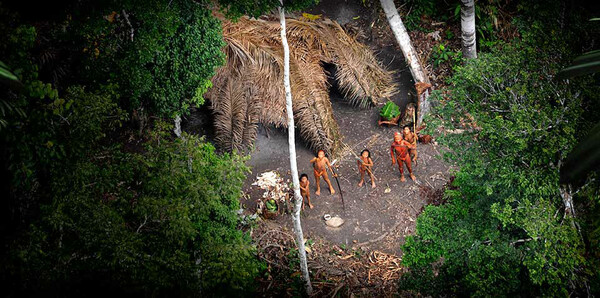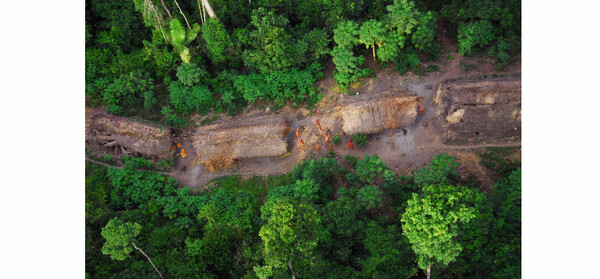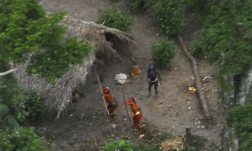

























Φωτ. Salome. Δύο μέλη της φυλής Jarawa στα ινδικά νησιά Andaman.
Time to Eat the Dogs
On Science, History, and ExplorationLost Tribe, Now Found
June 24, 2008 at 11:42 am · Filed under Expeditions
It turns out that the ‘lost tribe’ widely reported to have been found in the Brazilian rain forest a few months ago had only been temporarily misplaced. In truth, the Brazilian Indian Protection Agency (Funai), had known about this nomadic group for years.
The Guardian states:
Survival International, the organisation that released the pictures along with Funai, conceded yesterday that Funai had known about this nomadic tribe for around two decades. It defended the disturbance of the tribe saying that, since the images had been released, it had forced neighbouring Peru to re-examine its logging policy in the border area where the tribe lives, as a result of the international media attention. Activist and former Funai president Sydney Possuelo agreed that – amid threats to their environment and doubt over the existence of such tribes – it was necessary to publish them.
Two things strike me. First, we expect hard-ball tactics and outrageous propaganda from anti-environmental groups, but not from our idealistic conservationists. Were it only a matter of making something up, ok, bad enough. But strafing a village in order to get the photos? Poor form indeed. The former Funai president Sydney Possuelo defends the lie by saying it has caused Peru to reassess its logging practices. Yes, perhaps. But in the process it has destroyed the credibility of Funai and weakened the claims of other conservationists by association.
Second, what is behind our fascination with “lost” objects anyway? Sumathi Ramaswamy writes about this in The Lost Land of Lemuria: Fabulous Geographies, Catastrophic Histories (California: University of California Press, 2004). Loss, in her analysis, is a constructed thing, something we “make missing” in the past to satisfy social or political concerns in the present. (I will post a full book review on Thursday). The theme of the lost civilization or tribe catches fire in the nineteenth century and keeps burning into the 20th. For examples, see Journey to the Center of the Earth by Jules Verne (1864) or the The Wonderful Wizard of Oz by L. Frank Baum (1900)). The eagerness to capture lost peoples and places comes just as white Americans begin to seriously fret about the closing of the American frontier, race suicide, and manly decline (seeManliness and Civilization: A Cultural History of Gender and Race in the United States, 1880-1917 by Gail Bederman for a good synopsis of this). In any event, the Funai hoax proves that cult of the lost tribe is still alive and well in the 21st century. What gives?
First ever aerial footage of uncontacted Amazon tribe released
4 February 2011
Extraordinary film footage narrated by movie star Gillian Anderson has launched Survival International’s new campaign to protect some of the world’s last uncontacted tribes.
New film footage released today shows uncontacted Indians on the Brazil-Peru border in never-seen-before detail. It is the first-ever aerial footage of an uncontacted community.
Ms Anderson said today, ‘What comes across very powerfully from this amazing footage is how healthy and confident these people appear. I hope they can be left alone – but that will only happen if the loggers are stopped.’
The footage was filmed by the BBC in collaboration with the Brazilian government, for the new BBC 1 ‘Human Planet’ series (broadcast 3 Feb). The Brazilian government has authorized Survival to use the footage as part of its campaign. Photos of the tribe were published worldwide by Survival earlier this week.
Global coverage of the story has already pushed the Peruvian authorities into action – they have announced they will work with Brazil’s Indian Affairs department (FUNAI) to protect the area more effectively.
The Indians’ survival is in jeopardy as an influx of illegal loggers invades the Peru side of the border. Brazilian authorities believe the influx of loggers is pushing isolated Indians from Peru into Brazil, and the two groups are likely to come into conflict.
Survival Director Stephen Corry said today, ‘The very dangerous future for uncontacted tribal peoples should be of worldwide concern. Gillian Anderson’s help here will draw more attention to it – vital if the world is finally going to call a real halt to the centuries of destruction.’
"Uncontacted" Tribe
Photograph courtesy Gleison Miranda, FUNAI/Survival
Famously photographed aiming arrows at a passing aircraft two years ago, an "uncontacted" tribe in Brazil's Acre state (map) appears thriving and healthy in new pictures—the most detailed yet of the Amazon group—experts say.
Though referred to as uncontacted, the Indians—pictured by a palm-leaf hut—are thought to have had limited interaction with outsiders but prefer to remain isolated, according to José Carlos Meirelles, the Indian-affairs specialist who led the team that took the new pictures in April 2010. (See "'Uncontacted' Tribe Actually Known for Decades.")
Released this week by the international indigenous-rights group Survival International, the images were captured from about three-quarters of a mile (1.2 kilometers) away during an annual monitoring flight organized by the Brazilian government.
In keeping with federal policy, the team did not make direct contact, for fear of introducing diseases or harming the tribe's environment and culture.
"They always get scared when they see an aircraft, but this tribe is used to seeing commercial flights—Boeings and local jets—flying over the region," said the newly retired Meirelles, who for 40 years worked for FUNAI, Brazil's indigenous-rights agency.
"I prefer to get them scared once a year—and make sure they are healthy, growing in number, and protected from loggers and miners—rather than leave them without any supervision."
The isolated tribe's land, especially on the other side of the nearby Peruvian border, is much sought after for its lumber, oil, minerals, natural gas, and hydroelectric and farming potential.
In the face of increasing illegal logging, pictures like these are vital to safeguarding indigenous land rights, Meirelles said, given that politicians in both Brazil and Peru have disputed that such isolated tribes even exist.
(Also see "Five 'Uncontacted Tribes' Most Threatened With Extinction.")



























